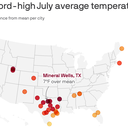U.S. heat wave: Here's where temperature records were set in July

New data shows that at least 43 locations across the U.S. set or tied for their hottest July on record, according to data from the National Oceanic and Atmospheric Administration (NOAA) via the Southeast Regional Climate Center.
Driving the news: The record-breaking temperatures were concentrated in Texas, Tennessee, Alabama, Mississippi, North and South Carolina and Oregon.
By the numbers: Also in July, at least 79 localities recorded their warmest average overnight low temperatures for the month, including nine that tied their records, while 38 locations had their hottest average maximum temperatures.
- In the Texas town of College Station, a previous 2009 record for its hottest average temperatures in July was shattered by 1.8°F, reporting an average temperature of 90.9°F.
- Salt Lake City had an average monthly temperature of 87.3°F, which was 1.6°F hotter than its previous all-time record for the month, which was set last year.
- San Antonio not only had its hottest July on record, with an average temperature of 89.8°F, which was 5°F above average for the month, but it also had its third straight month of record-breaking heat.
- Two of the locations are relatively difficult to break all-time heat records, and reflect warmer than average ocean temperatures, also related to climate change. These include Nantucket, Massachusetts, which beat its old monthly record by 1.3°F, and Robbinston, Maine.
The long duration heat in Texas, is noteworthy since it overlaps with a widespread, severe drought. A total of 60% of the state is in the most severe two categories of drought.
- This makes it easier for the air to reach extremely hot temperatures, but also further dries out soils in a feedback loop.
The intrigue: 11.4% of the 996 stations in the dataset recorded either their first, second or third-hottest July ever.
- 13% of them registered their first, second or third-highest average minimum temperatures for that month.
- Since July tends to be the warmest month of the year in much of the U.S. and Northern Hemisphere, many of the records also qualified as new milestones for the hottest month of any month on record.
Why it matters: In an average year, extreme heat is the leading weather-related killer in the U.S., according to the Centers for Disease Control and Prevention and the National Weather Service.
- Human-caused global warming from fossil fuel burning and other sources makes heat waves more likely, severe, frequent and longer-lasting.
- Extreme temperatures can affect power grids by boosting energy demands, exacerbate already-dire drought conditions and contribute to the frequency and intensity of wildfires.
A heat wave that recently hit the Pacific Northwest has killed at least seven people so far.
- And yet another heat wave is gripping the U.S.: On Wednesday, the heat is shifting east into the Plains, Midwest and Mid-Atlantic states, with more than 100 million under heat advisories yet again.
The big picture: Parts of the U.S. were engulfed by a heat wave last month that broke hundreds of daily and monthly weather records and put more than 100 million Americans under heat warnings and advisories for several days.
- It came after another extensive record-breaking heat wave persisted over large swaths of the country for several weeks in June.
The numerous nighttime temperature records broken last month is consistent with a trend caused by climate change: that nights on average are heating up faster than days.
- Abnormally hot temperatures throughout the night prevent people from cooling off from the day's heat, which greatly increases the risk of heat-related hospitalizations and deaths.
- Warm overnight temperatures can also contribute to wildfire intensity, since fire behavior typically dies down overnight when temperatures dip, the air cools and humidity increases. When this fails to take place, fires seize the opportunity to grow overnight as well.
- More than 39,ooo wildfires have burned over 5.75 million acres since Jan. 1 across the U.S., it added. The 10-year average for acres burned to date across the country is just 3.6 million acres.
Go deeper: We haven't built for this climate